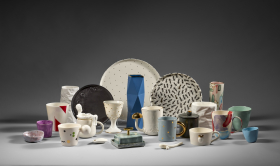-
NEWS
Exhibition “Testing Today’s World II”On display at the Riga Porcelain Museum from 18 November 2021 to 30 January 2022
The Riga Porcelain Factory has an important place in the history of porcelain manufacturing in Latvia. This enormous enterprise had over 2,000 employees and made several hundred line items, many of which now have the status of antiques. This factory is gone, and there is an erroneous view that as a result local porcelain also no longer exists. The aim of the exhibition “Testing Today’s World II” is to draw attention to the state of porcelain art and production today, more than 20 years after the demise of the “RPR” brand. Is it possible to speak about the porcelain of Riga and Latvia in a contemporary sense? Is it art? Are there any specific aspects of production? What is the characteristic style of contemporary porcelain?
Over the last decade, young porcelain artists have entered the Latvian design arena by opening new private studios. These artists have a different mode of thinking, based on open communication, globalised culture and creative competition. They have all been nurtured by the Latvian Art Academy. The Riga Design and Art Secondary School, which has long offered a synthesis between practical crafts and design thinking, has also played a major role.
The individual porcelain studio and workshop model is closely connected with both unique handicrafts and series-type design lines. Some of the brands have clearly distilled their trajectory based on their leader’s unique style, while in a few cases it balances between crafts, art and design. Since the makers themselves mostly work at the studios, the stylistics of the products are individualised and the range of products is relatively flexible. Nevertheless, the studios share some common characteristics, for example the designers are interested in free formal language, in which an important component is a sense of momentary randomness. These include both form casting as well as hand-shaping or lathing which does not avoid deformation. The decoration typically employs flowing glazing and subtle gold accents in the form of lines, dots etc. These porcelain products often reveal a witty approach, playing on materiality, subject matter or décor.
Eighteen artists, brands and studios, which are just a small part of the current scene, will take part in the exhibition: Piebalgas Porcelāna fabrika, MAALI, Malka Porcelain, Laine Berina Ceramics, ESSE, Oltes Ceramics, Rozenthal Ceramics Studio, IJ.ceramics, Aira Lesiņa, Informal ceramics, Katrīnas Keramika, KG keramika, Laima Ceramics, Linda Kivule Ceramics, Light Ceramics, Raceramic art & Studio, 2KG Concept Ceramic Atelier.
“Testing Today’s World II” also enables the Riga Porcelain Museum as an institution storing Latvia’s cultural heritage to record trends and phenomena the moment they arise, with the aim of preserving them for the future. In the first half of 2021, the museum staged the exhibition “Testing Today’s World,” which saw the main exposition supplemented by works by contemporary artists which are held in storage and not viewable every day. The exhibited works were produced from the late 1990s to the present, and offered a glimpse of how the museum would look if it also bore witness to contemporary developments rather than just ancient history. “Testing Today’s World II” attempts to draw close to the very latest trends, which are presently not represented in museum collections although they may deserve to be; it encourages us to reflect on what these “trends” are, and what today’s porcelain art and production look like.
Photo by Gvido Kajons.
-
THE UPCOMING EVENTS


.png)